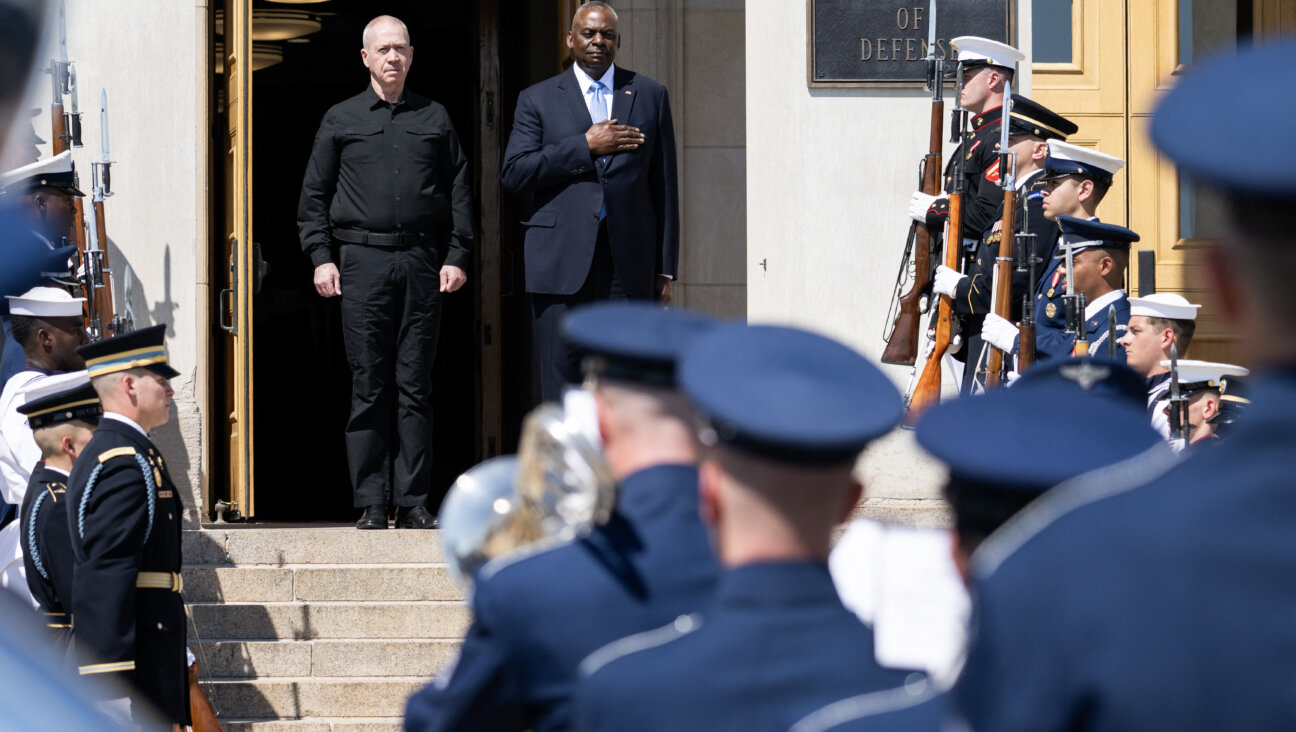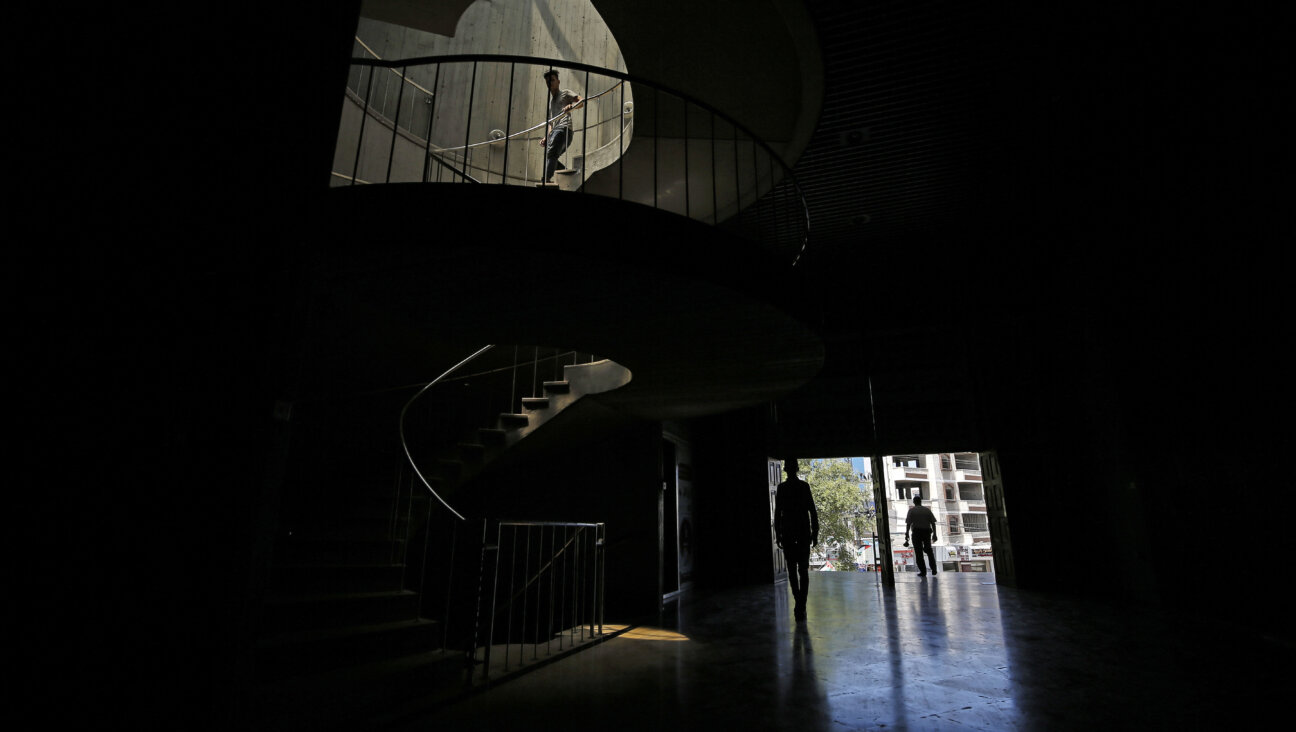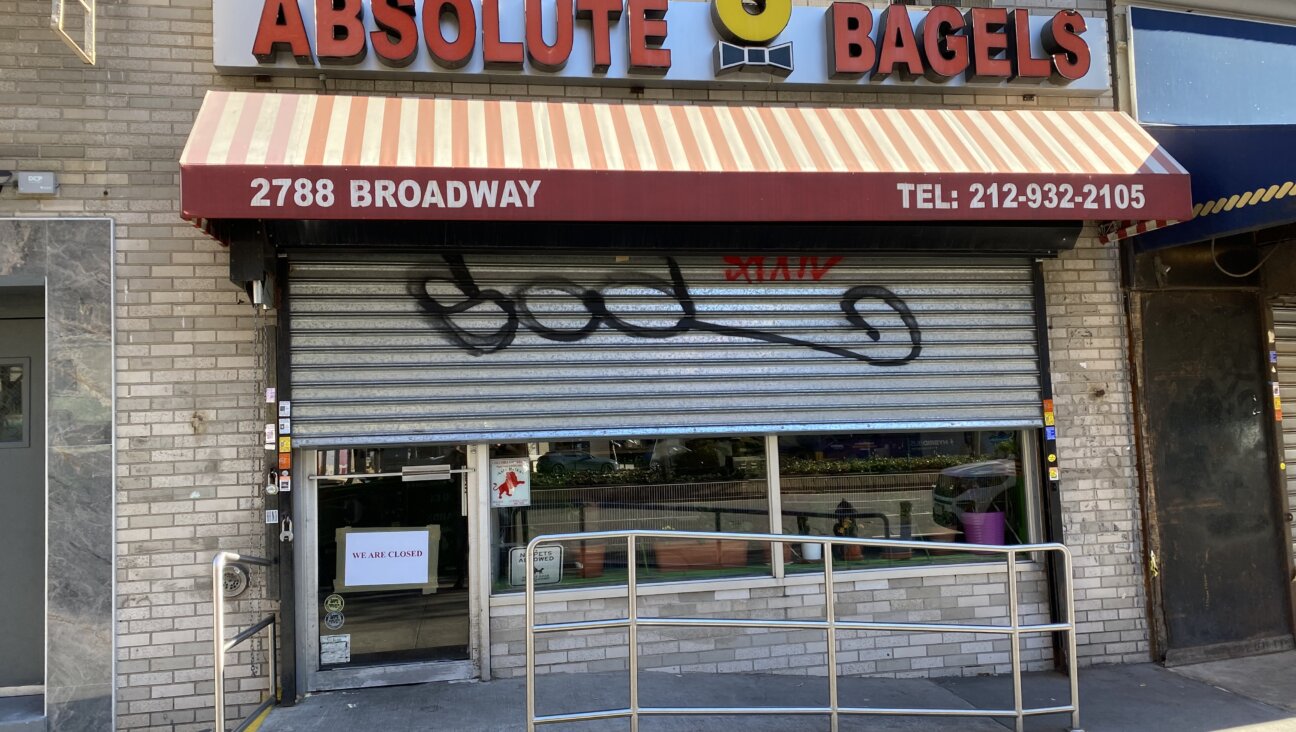Photo of Jew’s Lynching Goes on Block

A photograph of the 1915 lynching of Leo Frank, a Jewish pencil factory superintendent, in Marietta, Georgia, was sold for $3,125 at an auction.

Leo Frank Image by forverts
The warm-toned photograph on postcard stock includes a pencilled caption on the back by an unidentified hand with the words: “Hanging of Leo Frank.” It sold at Sotheby’s on October 3.
The seller of the postcard, a private New York collector, said he bought the postcard years ago. After realizing that he was never going to display the photo in his house (“too gruesome,” he said) and that there probably wasn’t much of a venue for showcasing it, he decided to put it on the block.
He approached all the major auction houses, but they declined the offer. “The subject matter was too controversial,” he said.
Finally, Sotheby’s agreed to auction it. Dan Abernethy, of Sotheby’s press office, said that it isn’t unusual for Sotheby’s to include famous images of important, yet disturbing historical events, such as the present work. This was not the only photograph related to Jewish history in last week’s sale, and it wasn’t the highest priced, either. A work by Roman Vishniac taken in Warsaw circa 1933-38 was also included, which sold for $5,000.
Calls made by Sotheby’s to the buyer of the lynching photo, regarding his or her identity, or the reason for the purchase, were not returned.
Frank, who was convicted in August 1913 for strangling his young employee, 13-year old Mary Phagan, is believed to be the only Jew ever lynched in the United States. Phagan was found strangled in the factory cellar. From the beginning, many people believed Frank to be innocent, and that it was, in fact, factory janitor Jim Conley, a black petty criminal, who murdered Phagan. The all-white jury accepted Conley’s testimony over Frank’s, however, and after merely one month, Frank was pronounced guilty and sentenced to death.

Leo Frank wrote to Forverts editor Ab Cahan about his murder conviction. Image by courtesy of Yivo
Most Georgians celebrated the verdict, but observers around the country were outraged.
Two years later, after Frank’s defenders succeeded in commuting the death sentence to life imprisonment, Frank was kidnapped from the state penitentiary, driven to the town where the Phagan family lived, and hanged from a tree. The lynching spawned the revival of the Ku Klux Klan as well as the founding of the Anti-Defamation League.
The false conviction of Leo Frank for murder, and his lynching two years later, had a traumatic impact on American Jewry, explained Steve Oney, author of the book, “And the Dead Shall Rise: The Murder of Mary Phagan and the Lynching of Leo Frank” (Pantheon Books, 2003). As Frank’s defenders worked diligently to commute his death sentence to life in prison, and even Georgia Gov. John Slaton campaigned and finally succeeded in doing so, the Southern Jews remained silent.
“The Jewish community in Atlanta then was 95% Reform,” Oney explained. “They were very assimilated and simply didn’t want to act too Jewish.”
“The Jews may have considered themselves white and accepted, but the trial and the subsequent lynching reminded them that they weren’t,” said Jonathan Sarna, Professor of American Jewish History at Brandeis University.
Northern Jews, on the other hand, rushed to defend Frank, and the New York Times led a series of articles on the story. “It was clear that New York Times Publisher Adolph Ochs saw it as a Jewish mission,” Sarna said. “But ultimately, the mission failed and the Times was attacked as ‘a Jewish paper’. No doubt, one of the reasons that the Times later failed to cover the Holocaust during World War II was tied to their earlier crusade for Leo Frank.”
While Frank sat in jail, the founding editor of the Forverts, Ab. Cahan went down to Georgia to visit him in March 1914 and wrote scores of articles in the Forverts in Frank’s defense.
Historically, the vast majority of lynching victims were black, often murdered by angry working class whites. This case was very different. As Oney discovered after years of painstaking research, the lynching was planned by 25 prominent men from Marietta, including a former Georgia governor, sheriffs, then- and former mayors of Marietta, a judge, local businessmen, a doctor, a banker, lawyers and an assemblyman. The actual lynching was done by mostly farmers and working men.
“In other words, big shots called the shots, and the middle and lower-class guys carried out their orders,” Oney said.
On August 16, 1915 the gang kidnapped Frank from Milledgeville State Penitentiary, drove him to Marietta, and hanged him from a tree on August 17. When word got out, thousands of onlookers arrived at the scene.
“Frank was not kidnapped from some county jail, but from the well-guarded state penitentiary in a highly orchestrated operation,” Oney said. The perpretators penetrated the prison late at night and drove the victim almost 150 miles to Marietta, close to the Phagan home. “This was not a lynch mob, but a military mission.”
Since the lynching party drove to the site in several automobiles, Oney learned their identities by looking through the auto registration for every resident of the county in that year. He also interviewed the sons and daughters of the alleged murderers, and one lynch party member even had a list of all the participants, which her father had given her and which she kept inside her Bible.
In January 2000, Stephen J. Goldfarb, a research librarian, posted one version of the list, with 23 names, on the Internet.
The decision of the lynch party to murder Frank, a Jew, rather than the black man Conley was very telling, Sarna said. “These folks saw in Leo Frank a symbol of the attack on the South, represented by all the values they had fought against: a Jew, a businessman, an assault on the South and on Southern womanhood,” Sarna said. “They sensed at the time that lynching Conley wouldn’t suffice. The public anger was so great that they wanted ‘something more’ than a black janitor.”
The people seen standing around the corpse in the photo were not the lynch party members, Oney explained, but some of the thousands of onlookers who arrived at the scene after word got out. Frank was hanged at 7 am and the body was taken down three hours later.
The lower part of Frank’s body is wrapped in burlap in order to hide his naked body, since he had been wearing only a nightshirt when he was kidnapped. The reason he was wearing a nightshirt rather than a prison uniform, Oney explained, is because weeks earlier, a fellow inmate had attempted to kill Frank, so in order to protect him, he had been transferred to the hospital unit of the penitentiary, where patients wore nightshirts.
In 1986 the Georgia State Board of Pardons and Paroles admitted culpability in failing to protect Frank or prosecute his killers, although they did not exonerate him. Today, a number of Marietta’s street signs still carry the names of the lynch party members.
Oney doesn’t believe that the street names should be changed, however. “We can’t go around re-writing history; that would be Stalinesque,” he remarked. “We’re not here to impose our version; just to tell the story.” Such a move would be controversial for another reason, too. Many of the families of the lynchers continue to be prominent members of the community, and in some cases, highly regarded figures, such as the brother of lynch planner Herbert Clay, General Lucius Clay, who was a World War II hero.
History provides its own vindicating irony, however. Today Marietta, the site of the infamous event, is a sought-after bedroom community. Cobb County, of which Marietta is the seat, has Georgia’s fastest growing Jewish community.
Oney says he would be interested to find out who the new owner of the photo is, and what was his or her reason for purchasing it. “I do hope it’s in good hands, and that the present owner appreciates it for the imporant moment in history that it represents,” he said.
Contact Rukhl Schaechter at [email protected]. This article was adapted from the Forverts.
A message from our Publisher & CEO Rachel Fishman Feddersen

I hope you appreciated this article. Before you go, I’d like to ask you to please support the Forward’s award-winning, nonprofit journalism during this critical time.
We’ve set a goal to raise $260,000 by December 31. That’s an ambitious goal, but one that will give us the resources we need to invest in the high quality news, opinion, analysis and cultural coverage that isn’t available anywhere else.
If you feel inspired to make an impact, now is the time to give something back. Join us as a member at your most generous level.
— Rachel Fishman Feddersen, Publisher and CEO
























